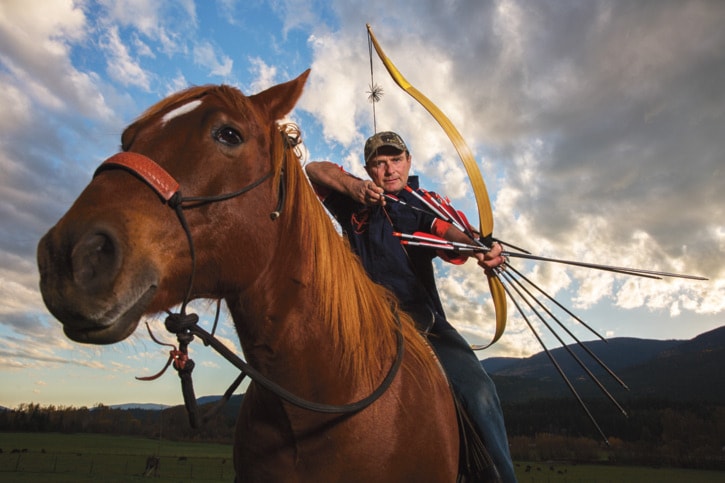Imagine life in 400 AD as a nomadic Hun warrior in the heat of battle on the steppes of Eastern Europe.
Or perhaps as a Comanche Indian hunting buffalo on the plains of the great west.
Both civilizations were skilled horsemen and archers, who combined the two skills into horseback archery.
The Huns used this technique in warfare, while the Plains Indians used it as a hunting method.
“When you read about the history of horseback archery, it becomes very intriguing to revive this tradition,” says Donat Koller.
An avid archer and equestrian, Koller stumbled upon the sport and, since then, he says he has been hooked.
He explains that he enjoyed both archery and horseback riding as separate hobbies, so when he discovered the sport it made perfect sense to combine the two.
“I was looking for something different to do, something that would challenge and push my limits,” Koller states.
That was five years ago.
Today Koller actively trains and participates in horseback archery events a few times year as a member of the Borsos Torzs Horse Archery Club, based in Mount Currie, B.C.
He even has his own private home-made training facility on his acreage.
Koller says archery is a mind game on its own, and taking aim while on horseback takes it to another level.
“The sport is not just about the physical aspect, in a way it’s more about the mind, and I find that very challenging in a great way.”
He stresses that a rider must first be completely comfortable on horseback, able to ride without undue concentration.
“In a split second if you turn you attention to the horse and what your lower body is doing, you will lose focus on the target and miss your shot.”
As a rider he always strives to be constantly aware while in the saddle, which translates into the process becoming second nature.
“In between shots you have to train the brain that there is an endless amount of time before the next target, and here and there I am starting to pick up on that and it’s a really cool feeling,” he says smiling.
Koller explains that it is difficult to find the time to practice, juggling his own business and family life. He estimates he only manages to practice for about three hours a week.
After emigrating to Canada in 1993 from Switzerland, Koller and his wife Jasmine opened up Happy Days Goat Dairy, making cheese, yoghurt, ice cream and milk.
In the winter months Koller can be found in the barn sitting on a wooden horse, working on the technical aspects of holding up to seven arrows and a bow in one hand while shooting and reloading as quickly as possible.
Horseback archers use a bow that is smaller, lighter and simpler than most modern-day bows.
Most archers use a bow that weighs between 30 and 40 pounds, and doesn’t have an arrow rest.
There are two main riding styles in the sport today.
Koller has modelled his training after the more classical Hungarian style of horseback archery, as opposed to the newer Korean style of riding.
This past month, Koller and three fellow Canadians made the 8,200-kilometre journey to Seoul, South Korea to compete in the 10th annual World Horseback Archery Championships.
More than 60 athletes from 14 nations competed in both Hungarian and Korean disciplines.
Koller and his teammates claimed a silver medal in a team event called mogu, a Korean archery game that simulates a hunting exercise.
A rider tows a large canvas ball behind the horse while a team of two archers attempts to track down the other rider and shoot the canvas ball with blunt arrows that have been dipped in paint.
Points are awarded for how many arrows hit the ball and where the ball is hit.
“We were given two very good, very fast Arabian horses. The horses knew what to do and ran right up alongside the ball, and I just nailed it and got us three points,” says Koller, grinning from ear to ear.
“It was our first time doing this event, it was really thrilling.”
Koller has nothing but positive things to say about the way the competition was organized and would love to return to the international stage.
He insists he only does the sport for fun and to see his own growth and improvement, not for prizes or awards.
“For me it’s kind of like a form of meditation and relaxation, a way to get away from work, and do something else.”
“I will only stop when I can no longer swing my leg over the horse,” he says laughing.
